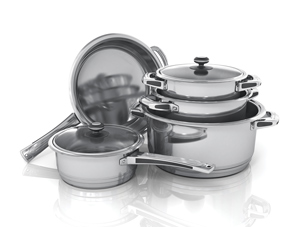Although warewashing tends to get overlooked because it does not generate revenue in foodservice operations, the dishwashing area typically features some of the foodservice operation’s most expensive equipment. The type of unit that best suits a foodservice operation depends on the kitchen, restaurant’s volume and the items the unit will wash.
 Most warewashing machines feature stainless steel construction and almost all feature common utility connections. Other common features include door safety switches, idle pump shut-offs, tank heaters and low-water tank heat protection. After that, features will vary greatly by unit type and manufacturer.
Most warewashing machines feature stainless steel construction and almost all feature common utility connections. Other common features include door safety switches, idle pump shut-offs, tank heaters and low-water tank heat protection. After that, features will vary greatly by unit type and manufacturer.
Undercounter dishmachines can include built-in electric booster heaters, top-mounted slide-out controls, larger door openings, double-wall construction to limit noise, fully automatic wash and rinse cycles, extended and shortened wash cycles, self-sealing gasket-less doors, upper and lower wash and rinse spray systems, removable rack glides for easy cleaning and flexible hoses designed to make installation easier.
Door-type machines, suitable for applications where the operator has limited space, typically feature automatic tank fills, door-activated drains, front-mounted tanks for easier cleaning, built-in 40-degree F or 70-degree F rise booster heaters, straight-through or corner-model configuration, top-mounted controls, interchangeable upper and lower spray arms, 1-hp pump motors and detergent/chemical connection provisions.
Flight-type or rackless warewashing units typically include dual fresh-water rinse functions. These systems’ large removable panels and inclined, self-cleaning tanks can help simplify daily maintenance. These systems’ double-wall insulation reduces noise and retains heat. Units’ wash-arm designs maximize pressure, which can result in more soil removal. These units come in one-, two- and three-tank models.
Rack conveyors most often feature automatic tank refill, leak-proof doors, rinse-saver devices, 2-hp wash pumps, a door-activated drain closure, removable spray arms, convenient top-mounted controls and interchangeable spray arms.
Upright conveyor systems usually have extra-wide conveyors for high-capacity operations. Some standard features include idle pump shut-offs, rinse savers, top-mounted control consoles, push-button start-stop controls on the load end, conveyor shut-off shelves on the unload end, common drains and electric connections, chemical dispensing connection provisions and water regulating valves. Upright conveyor systems also usually offer a choice of tank heat: electric, steam coils or direct steam injectors. Some units feature access doors on both sides of the hood and clean-out doors on the end and sides of a machine for easier access. Many models offer a choice of left- or right-hand conveyor travel. Single and two-tank units are available.
Circular conveyor machines usually feature automatic tank fills, a choice of chain or upright conveyor peg belts, splash protection, start-stop stations and load-end and top-mounted controls.
There also are warewashers designed to clean specific types of items, with the water dispersed from the cleaning arms in a specific pattern. The farther away the arm’s nozzles are from the wares being sanitized, the more that pattern is lost. Cleaning is then less efficient. These specialized units have arms positioned as close to wares as possible while still allowing room for clearance. These include pot and pan washers, utensil washers and glasswashers.
Glasswashers generally feature a built-in dispensing system for detergent, rinse additives and sanitizers, and an automatic conveyor drive system. These single-switch machines feature separate wash and rinse temperature gauges, powerful wash pump motors and a 100-percent fresh-water rinse, which can eliminate rinse-water contamination problems.
Pot, pan and utensil washers typically feature separate wash and rinse tanks, self-contained booster heaters, adjustable wash and rinse cycles with a selector switch, high-velocity spray nozzles designed for fast stripping action, an external pre-rinse wash-down hose, automatic fill functions on utensil models, heavy-duty racking systems, electric, steam or gas heating systems and, sometimes, a loading ramp or pit grid for rack washers.
Operators can opt to customize their warewashing machines to meet the specific needs of the business. For example, adding a motorized rack advance curve and a roller table to a rack conveyor machine allows a smaller dishroom to provide high-volume warewashing. Cantilever sideloader tables, on the other hand, allow for loading of racks from the front of a machine, thus saving space in a smaller dish room. Operators can program many machines with customized wash and rinse times that meet specific requirements.
Spray nozzles in conveyor-type warewashers can cut the amount of water required by 50 percent, thereby providing savings by reducing water usage, the amount of energy required to heat water and cutting rinse agent/chemical use. Such technology can offer up-front savings by allowing operators to purchase a smaller water booster heater with their machines.
Commercial dishwashers that have earned the Energy Star designation are said to be 40 percent more energy efficient and 50 percent more water efficient, on average, than standard models. The Energy Star designation applies to high temp (hot water sanitizing), low temp (chemical sanitizing) and dual sanitizing machines. This includes under counter; single tank, door type; single tank, conveyor; multiple tank, conveyor and flight type machines. Glass washing machines; pot, pan, and utensil machines may also earn earn Energy Star status.



